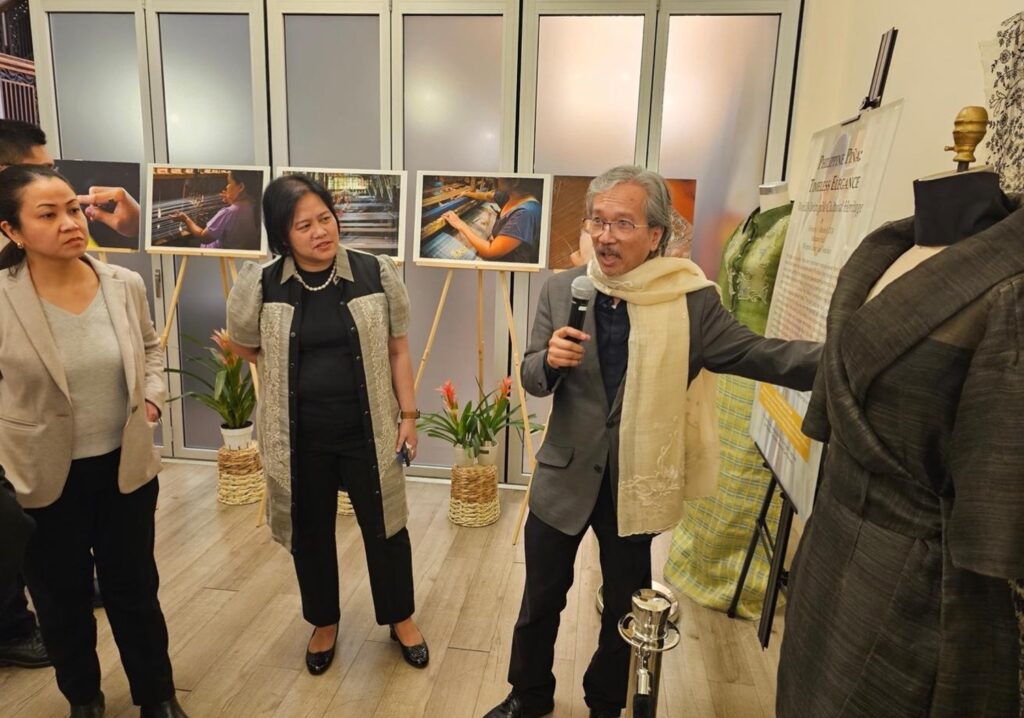“PHILIPPINE PIÑA” EXHIBIT AT PH CONSULATE TURNS SPOTLIGHT ON PINEAPPLE FABRIC AS WORLD’S NEW INTANGIBLE CULTURAL HERITAGE

Philippine Consul General in San Francisco Neil Ferrer (center-right) are joined by The Hinabi Project President Maya Ong Escudero (extreme right), Vice President and exhibit curator Edwin Lozada (center-left), and Board Member Melissa Louise Sobrepeña at a ribbon-cutting ceremony to open “Philippine Piña: Timeless Elegance– World’s Intangible Cultural Heritage” exhibit on 5 February 2024. (San Francisco PCG photo)
SAN FRANCISCO, USA – The Philippine Consulate General in San Francisco has partnered with The Hinabi Project for an exhibit that celebrates the recent inclusion of the Philippine piña (pineapple) fabric in the list of world intangible cultural heritage. The exhibit is the second to be held at the Consulate this year.
Held under the auspices of Sentro Rizal San Francisco, the Consulate co-organized the opening of the “Philippine Piña: Timeless Elegance– World’s Intangible Cultural Heritage” exhibit on 5 February 2024 at the Philippine Center in San Francisco’s Kalayaan Hall.
In his remarks, Consul General Neil Ferrer said that the exhibit comes on the heels of Philippine Tropical Fibers Month last January 2024, “an entire month dedicated to promoting natural textiles, advancing local industries, and creating livelihood opportunities for Filipinos.”
“At the heart of the Philippine Tropical Fibers Month celebration is the desire to showcase a wide spectrum of natural fibers sourced within the Philippines—from the piña, abaca, banana and bamboo, to the Philippine silk. These materials demonstrate the rich biodiversity of the Philippines, and the creativity and ingenuity of the Filipinos,” the Philippine Consul General said.
Consul General Ferrer also talked on the Philippine piña and the inclusion of the Aklan piña handloom weaving in the Representative List of the Intangible Cultural Heritage of Humanity of the United Nations Educational, Scientific and Cultural Organization (UNESCO), at the 18th Session of the Intergovernmental Committee for the Safeguarding of Intangible Cultural Heritage in December 2023.
The Philippine Consul General quoted National Commission for Culture and the Arts Chairperson Victorino Manalo, in saying that “the Philippines is the only country that extensively produces piña cloth in the whole world… They stand out as national cultural icons symbolizing ingenuity, craftspersonship, and social cohesiveness as well as shared values of our communities.”
Consul General Ferrer thanked The Hinabi Project “for being staunch advocates of Philippine natural textiles and weaves here in the United States, and for being champions of our local artisans and indigenous communities back home.”
“The Hinabi Project has long been a reliable partner of the Consulate in Philippine cultural promotion and diplomacy efforts in the Bay Area, and we thank you for your relentless efforts in showcasing the talent and creativity of our people here in America,” the Philippine Consul General said.
For her part, The Hinabi Project President and Acting Executive Director Maya Ong Escudero thanked the Consulate for the opportunity of holding their first exhibition of 2024 at the Philippine Center, and revealed her group’s plan to mount another exhibit featuring the Ilocos inabel and Gawad Manlilikha ng Bayan awardee Magdalena Gamayo, who will celebrate her 100th birthday this year.
A 10-minute video produced by UNESCO on Aklan piña handloom weaving was played during the exhibit opening. Following a ribbon-cutting ceremony, The Hinabi Project Vice President and exhibit curator Edwin Lozada led a guided tour of the exhibition.
The Philippine piña is an extraordinary textile made by weaving the fibers of the leaves of the pinyang Bisaya or Ananas comosus, which was introduced in the Philippines from Mexico sometime in the 16th century via the Manila-Acapulco galleon trade. Its light, airy fabric is perfectly suitable to the Philippines’ hot tropical climate.
Piña-made Barong Tagalog was worn by world leaders such as U.S. Presidents Bill Clinton, Barack Obama and Donald Trump during the Philippines’ hosting of the Asia Pacific Economic Cooperation (APEC) Economic Leaders Meetings in 1996 and 2015, and the Association of Southeast Asian Nations (ASEAN) Summit in 2017.
The “Philippine Piña: Timeless Elegance– World’s Intangible Cultural Heritage” exhibit will run at the Philippine Center until 8 March 2024, International Women’s Day. END

Consul General Neil Ferrer gives his remarks during the opening of “Philippine Piña: Timeless Elegance– World’s Intangible Cultural Heritage” exhibit at the Philippine Center’s Kalayaan Hall on 5 February 2024. (San Francisco PCG photo)


The Hinabi Project Vice President and exhibit curator Edwin Lozada leads a guided tour of “Philippine Piña: Timeless Elegance– World’s Intangible Cultural Heritage” exhibit at the Philippine Center’s Kalayaan Hall on 5 February 2024. (San Francisco PCG photos)

Consul General Neil Ferrer receives a copy of “Piña”, a book by Lourdes Montinola that is considered an authoritative resource on the Philippine pineapple fabric, at the opening of the “Philippine Piña: Timeless Elegance– World’s Intangible Cultural Heritage” exhibit on 5 February 2024. (San Francisco PCG photo)
